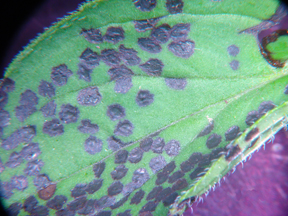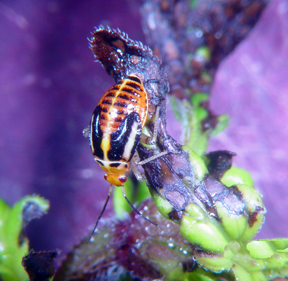Fourlined plant bug nymphs wreaking havoc in East Lansing
Editor’s note: This article is from the archives of the MSU Crop Advisory Team Alerts. Check the label of any pesticide referenced to ensure your use is included.
A very distraught lady came to the lab today with one of her favorite perennials in hand. The leaves were covered with small circular black lesions that look like some kind of disease symptom. Sitting on one of the stems of her plant was the culprit, a fourlined plant bug nymph, Poecilocapsus lineatus (Hemiptera: Miridae). The fourlined plant bug has been recorded feeding on 250 plant species, most of which are herbaceous plants. The insect gets its common name from the four black stripes present on its front wings of the adults. This insect can extensively damage the leaves of its host by its feeding. Like all plant bugs, the fourlined plant bug has piercing mouthparts that are inserted into the leaf to suck out plant juice. In doing so, the bug injects saliva that contains enzymes that kill the plant tissue directly around the feeding puncture. Both fourline plant bug nymphs and adult bugs cause characteristic necrotic spots, which might be confused with disease symptoms. This bug overwinters in the egg stage. The eggs hatch in early to mid-May in Michigan. Nymphs require 30 days or so to develop into adults.
There are two to three generations each year, but the most damage I have experienced in my garden has been caused by the first generation. The fourlined plant bug attacks the upper leaves first and only a small number of these “recreational feeders” is required to cause extensive damage. It is best to spray these insects when they are first noticed. Sevin or Malathion will help control them on edible garden plants. Cyfluthrin (sold as Bayer Advanced Garden Insect Control) can be used on non-edible plants. You can try Safer's Insecticidal Soap if you are concerned about using inorganic insecticides, but Safer’s is known to cause phytotoxicity problems on some species of plants. Picking these fast moving, elusive bugs by hand can be very frustrating. Any spray applied during bloom may damage the flowers. Be sure to read and follow all instructions and safety precautions found on the label before using any pesticide.



 Print
Print Email
Email





